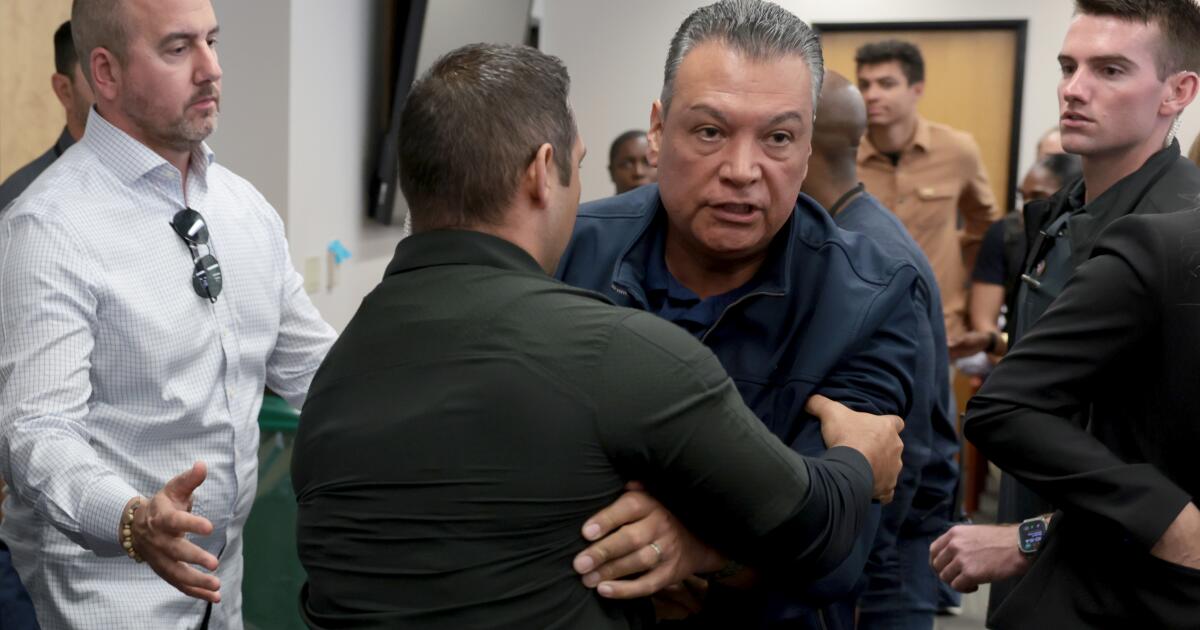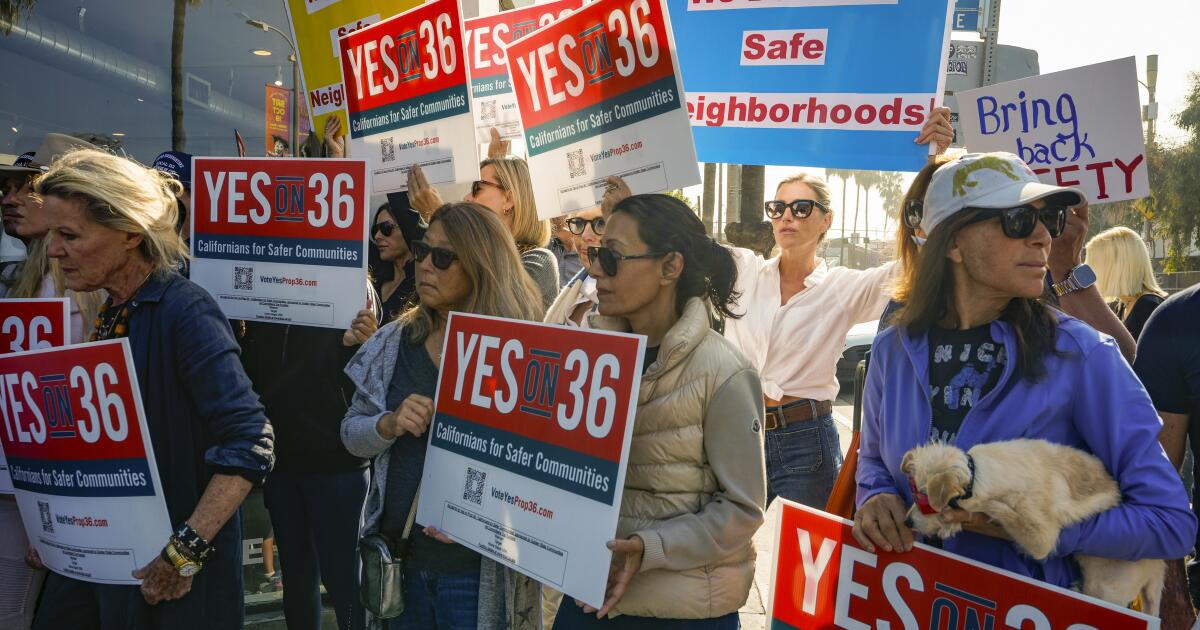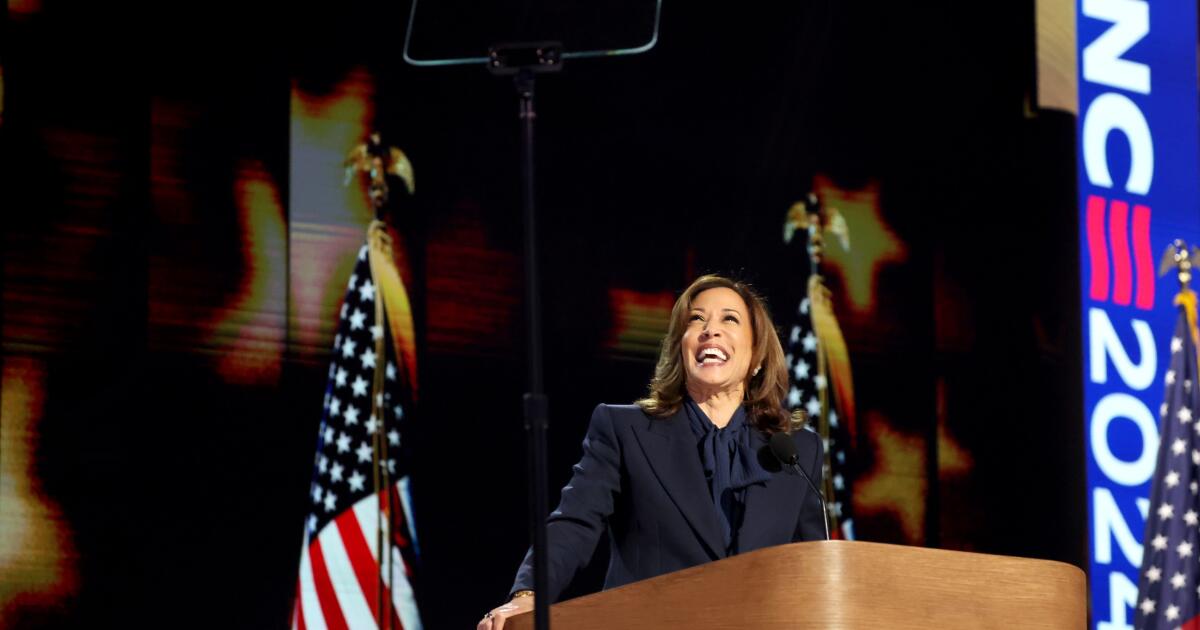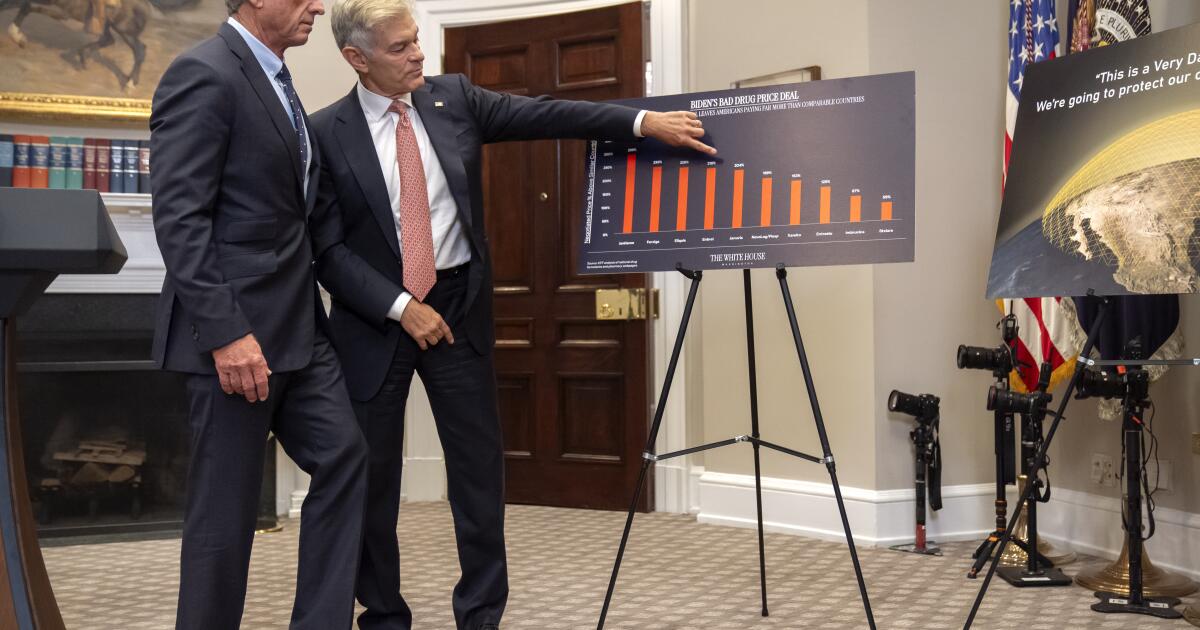Column: Padilla was right to challenge Noem’s right-wing lunacy
Newsletter
You’re reading the L.A. Times Politics newsletter
Anita Chabria and David Lauter bring insights into legislation, politics and policy from California and beyond. In your inbox three times per week.
You may occasionally receive promotional content from the Los Angeles Times.
SACRAMENTO — Sen. Alex Padilla had heard all he could stand from Homeland Security Secretary Kristi Noem. For good reason. She was sounding like a military dictator and brushing off California voters.
So the California senator interrupted her. He tried to ask a question — and wound up being shoved out of the room by federal bodyguards, strong-armed to the floor and handcuffed.
This is how the Trump administration intends to “Make America Great Again”?
The unprecedented act of disrespecting and roughing up a U.S. senator occurred at the Westwood federal building during a Noem news conference Thursday. Padilla, a Democrat, was standing behind reporters when the secretary said federal agents would continue to conduct immigration raids in Los Angeles indefinitely.
“[We’ll] continue to sustain and increase our operations in this city,” Noem said.
“We are not going away,” she emphasized. “We are staying here to liberate the city from the socialist and the burdensome leadership that this governor and this mayor have placed on this country.”
Definitely fighting words.
“Liberate” the city? That’s the sort of language used by dictators — fascist, Communist or any Third World despot.
“Socialist” leadership? A pejorative straight out of the right-wing playbook of political talking points.
Was Noem saying the Trump administration’s real goal is to overthrow Gov. Gavin Newsom and Mayor Karen Bass because of their “burdensome” regimes?
Perhaps the secretary has forgotten what she presumably was taught in civics class.
Noem talks without thinking
But Noem, 53, was governor of South Dakota. And before that she was a member of the U.S. House of Representatives and a state legislator. So she knows about the election process. And we can only conclude that, at her news conference, she was talking without thinking.
Because in America, the “liberators” are the voters. Not immigration agents, Cabinet secretaries or even the president.
California citizens reelected Newsom by a 59% landslide vote in 2022. The Democrat will be termed out of office next year — a policy set by voters, not by some federal administration.
Bass also was elected in 2022 by a margin of nearly 10 percentage points. If Angelenos want to liberate themselves from her, they’ll have the opportunity when she’s up for reelection next year.
Socialist is such a tired characterization of practically any policy the political right doesn’t like. You could tag lots of government spending with socialism — including Social Security and Medicare.
Anyway, Padilla listened to Noem’s dumb comments about liberating citizens from the governor and mayor, and, he said later in TV interviews, “it was just too much.”
He broke in with a shouted question.
OK, he shouldn’t have done that. There’s a protocol at formal news conferences. Only reporters ask questions. Certainly not visiting politicians. And questioners really shouldn’t interrupt the person at the lectern, although it happens.
This wasn’t a Senate committee hearing in which Padilla could ask anything he wanted — when it was his turn. He wasn’t “doing his job” at Noem’s event, as his Democratic colleagues later asserted. He was there as an observer. If he wanted to ask the secretary a question, this wasn’t the time or place.
Wrong but understandable
But his emotional reaction to Noem’s comments was totally understandable.
Padilla ordinarily is a very polite guy, extraordinary civil — calm, soft-spoken, the opposite of an aggressive loudmouth.
But he is passionate about the cause of immigrant rights and comprehensive reform that would offer a path to citizenship for undocumented people. It’s what inspired him to enter politics.
He was motivated by Latino activists’ losing fight in 1994 against Proposition 187, which would have denied most public services to immigrants living here illegally if it wasn’t tossed out by a judge.
Padilla, 52, is a proud L.A. native, the son of Mexican immigrants. His dad was a short-order cook, and his mom cleaned affluent people’s houses. He graduated from the Massachusetts Institute of Technology with a mechanical engineering degree. But he caught the political bug and was elected to the L.A. City Council at age 26.
Later he was elected to the state Senate and as secretary of state. He ultimately became California’s first Latino U.S. senator.
On Thursday, the lawmaker was at the federal building to meet a general. He heard Noem was holding a news conference, asked to attend and was escorted in.
After he was forced to the ground by federal agents who considered him a security threat, Padilla declared repeatedly: “If that’s what they do to a United States senator with a question, imagine what they do to farmworkers, day laborers, cooks and the other nonviolent immigrants they are targeting in California and across the country.”
White House Communications Director Steven Cheung claimed Padilla acted like “a complete lunatic … by rushing toward Secretary Noem.” Noem said he “lunged” at her.
Wrong. A video recording disproved that.
Federal bodyguards contended Padilla didn’t identify himself. More bull. They just didn’t listen.
“Hands off! I am Sen. Alex Padilla,” he’s heard saying and repeating several times on the recording.
A federal agent turned to a Padilla staffer recording the sorry incident and said: “There’s no recording allowed out here, per FBI rights.”
Sorry. If it’s a right not to be recorded piling on a senator trying to exercise his rights, then it should be repealed.
The Trump administration did another stupid thing. Padilla came out a hero.
What else you should be reading
The must-read: ‘Protest is patriotic.’ ‘No Kings’ demonstrations across L.A. against ICE sweeps, Trump presidency
The TK: Will mom get detained? Is dad going to work? Answering kids’ big questions amid ICE raids
The L.A. Times Special: Voices from the raids: How families are coping with the sudden apprehension of loved ones
Until next week,
George Skelton
—
Was this newsletter forwarded to you? Sign up here to get it in your inbox.









